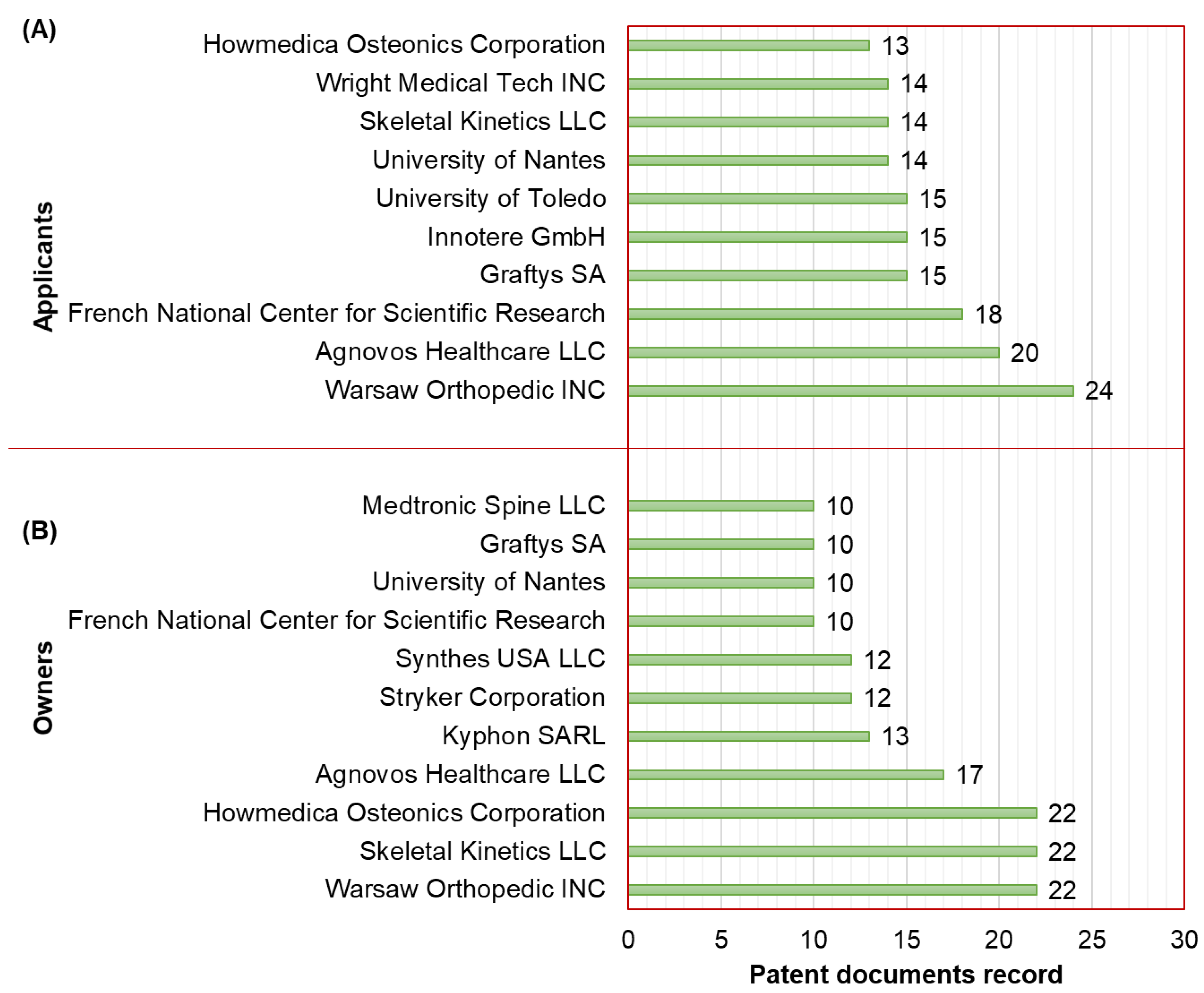Development of Calcium Phosphate Cements for Bone Repair: An Overview Based on Patent Analysis †
Abstract
:1. Introduction
2. Resources and Methodology
3. Results and Discussion
3.1. Patent Documents and Legal Status
3.2. Publication Dates
3.3. Applicants and Owners
3.4. Patent Classifications
3.5. Patent Jurisdictions
4. Conclusions
Author Contributions
Funding
Institutional Review Board Statement
Informed Consent Statement
Data Availability Statement
Acknowledgments
Conflicts of Interest
References
- Xu, H.H.K.; Wang, P.; Wang, L.; Bao, C.; Chen, Q.; Weir, M.D.; Chow, L.C.; Zhao, L.; Zhou, X.; Reynolds, M.A. Calcium phosphate cements for bone engineering and their biological properties. Bone Res. 2017, 5, 17056. [Google Scholar] [CrossRef] [PubMed]
- Turnbull, G.; Clarke, J.; Picard, F.; Riches, P.; Jia, L.; Han, F.; Li, B.; Shu, W. 3D bioactive composite scaffolds for bone tissue engineering. Bioact. Mater. 2018, 3, 278–314. [Google Scholar] [CrossRef] [PubMed]
- Song, Y.; Zhang, C.; Wang, P.; Wang, L.; Bao, C.; Weir, M.D.; Reynolds, M.A.; Ren, K.; Zhao, L.; Xu, H.H.K. Engineering bone regeneration with novel cell-laden hydrogel microfiber-injectable calcium phosphate scaffold. Mater. Sci. Eng. C 2017, 75, 895–905. [Google Scholar] [CrossRef] [PubMed]
- Verron, E.; Khairoun, I.; Guicheux, J.; Bouler, J.-M. Calcium phosphate biomaterials as bone drug delivery systems: A review. Drug Discov. Today 2010, 15, 547–552. [Google Scholar] [CrossRef] [PubMed]
- Dorozhkin, S.V. Calcium Orthophosphate Cements and Concretes. Materials 2009, 2, 221–291. [Google Scholar] [CrossRef]
- Julien, M.; Khairoun, I.; LeGeros, R.Z.; Delplace, S.; Pilet, P.; Weiss, P.; Daculsi, G.; Bouler, J.M.; Guicheux, J. Physico-chemical–mechanical and in vitro biological properties of calcium phosphate cements with doped amorphous calcium phosphates. Biomaterials 2007, 28, 956–965. [Google Scholar] [CrossRef] [PubMed]
- Google. Google Patents. Available online: https://patents.google.com (accessed on 5 January 2023).
- Baxendale, L.; Kirk, E.E.J. Dental Fillers and Bone Cements Comprising Collagen. Granted Patent GB1068587A, 10 May 1967. [Google Scholar]
- Hachimi Alaoui, C.; Fatimi, A. A 20-year patent review and innovation trends on hydrogel-based coatings used for medical device biofabrication. J. Biomater. Sci. Polym. Ed. 2023, in press. [Google Scholar] [CrossRef] [PubMed]
- Fatimi, A. A patent data analysis of the innovation trends in biological control agent formulations. Recent Adv. Food Nutr. Agric. 2022, 13, 59–69. [Google Scholar] [CrossRef] [PubMed]
- Fatimi, A. Exploring the patent landscape and innovation of hydrogel-based bioinks used for 3D bioprinting. Recent Adv. Drug Deliv. Formul. 2022, 16, 145–163. [Google Scholar] [CrossRef] [PubMed]
- Song, C.H. Examining the Patent Landscape of E-Fuel Technology. Energies 2023, 16, 2139. [Google Scholar] [CrossRef]
- Barbosa, N.B.; Nunes, D.D.G.; Santos, A.Á.B.; Machado, B.A.S. Technological Advances on Fault Diagnosis in Wind Turbines: A Patent Analysis. Appl. Sci. 2023, 13, 1721. [Google Scholar] [CrossRef]
- Zhu, Y.; Wang, Y.; Zhou, B.; Hu, X.; Xie, Y. A Patent Bibliometric Analysis of Carbon Capture, Utilization, and Storage (CCUS) Technology. Sustainability 2023, 15, 3484. [Google Scholar] [CrossRef]
- Frisio, D.G.; Ventura, V. Global Innovation Trends for Plant-Based Vaccines Production: A Patent Analysis. Plants 2021, 10, 2558. [Google Scholar] [CrossRef] [PubMed]
- Francis, N.; Ong, A.; Suhaimi, H.; Abas, P.E. Patent Landscape Review on Ankle Sprain Prevention Method: Technology Updates. Inventions 2023, 8, 53. [Google Scholar] [CrossRef]
- European Patent Office. Espacenet Patent Search. Available online: https://worldwide.espacenet.com (accessed on 25 January 2023).
- United States Patent and Trademark Office. USPTO Database (PatFT-AppFT). Available online: https://uspto.gov/patents/search (accessed on 5 January 2023).
- European Patent Office. Espacenet Glossary. Available online: https://worldwide.espacenet.com/patent/help/espacenet-glossary (accessed on 25 January 2023).
- World Intellectual Property Organization. Summary of the Patent Cooperation Treaty (PCT). Available online: www.wipo.int/treaties/en/registration/pct/summary_pct.html (accessed on 25 January 2023).




| CPC Code | Description |
|---|---|
| A61L2430/02 | Materials or treatments for tissue regeneration, such as reconstruction of bones with weight-bearing implants |
| A61L27/12 | Inorganic materials for grafts or prostheses, such as phosphorus-containing materials |
| A61L24/02 | Surgical adhesives or cement adhesives for colostomy devices containing inorganic materials |
| A61L2400/06 | Materials characterized by their function or physical properties, such as flowable or injectable implant compositions |
| A61L27/54 | Biologically active materials (e.g., therapeutic substances) |
| A61L27/58 | Materials characterized by their function or physical properties, such as materials that are at least partially resorbable by the body |
| A61L27/50 | Materials characterized by their function or physical properties (e.g., injectable or lubricating compositions, shape-memory materials, and surface-modified materials) |
| C04B2111/00836 | Mortars, concrete or artificial stone, or preparation mixtures, distinguished by a specific function, property, or use in medical or dental applications |
| A61L24/0015 | Surgical adhesives or cement adhesives, for colostomy devices, characterized by their function or physical properties, such as medicaments or biocides |
| A61L27/56 | Materials characterized by their function or physical properties, such as porous materials (e.g., foams or sponges) |
Disclaimer/Publisher’s Note: The statements, opinions and data contained in all publications are solely those of the individual author(s) and contributor(s) and not of MDPI and/or the editor(s). MDPI and/or the editor(s) disclaim responsibility for any injury to people or property resulting from any ideas, methods, instructions or products referred to in the content. |
© 2023 by the authors. Licensee MDPI, Basel, Switzerland. This article is an open access article distributed under the terms and conditions of the Creative Commons Attribution (CC BY) license (https://creativecommons.org/licenses/by/4.0/).
Share and Cite
Khairoun, K.; Laazizi, A.; Fatimi, A. Development of Calcium Phosphate Cements for Bone Repair: An Overview Based on Patent Analysis. Mater. Proc. 2023, 14, 28. https://doi.org/10.3390/IOCN2023-14472
Khairoun K, Laazizi A, Fatimi A. Development of Calcium Phosphate Cements for Bone Repair: An Overview Based on Patent Analysis. Materials Proceedings. 2023; 14(1):28. https://doi.org/10.3390/IOCN2023-14472
Chicago/Turabian StyleKhairoun, Khalid, Abdellah Laazizi, and Ahmed Fatimi. 2023. "Development of Calcium Phosphate Cements for Bone Repair: An Overview Based on Patent Analysis" Materials Proceedings 14, no. 1: 28. https://doi.org/10.3390/IOCN2023-14472
APA StyleKhairoun, K., Laazizi, A., & Fatimi, A. (2023). Development of Calcium Phosphate Cements for Bone Repair: An Overview Based on Patent Analysis. Materials Proceedings, 14(1), 28. https://doi.org/10.3390/IOCN2023-14472







